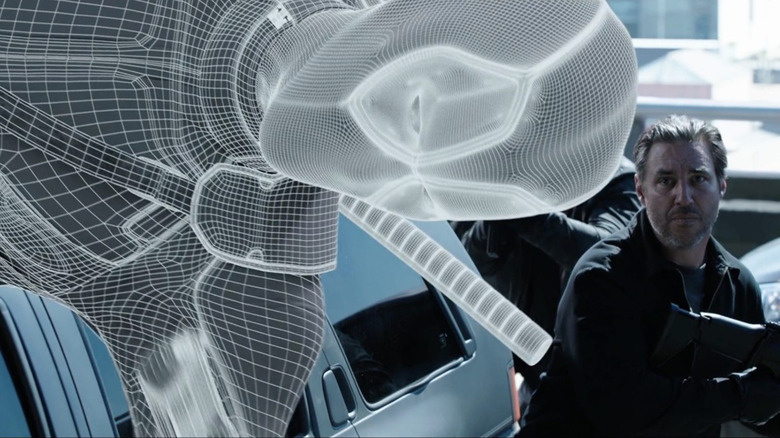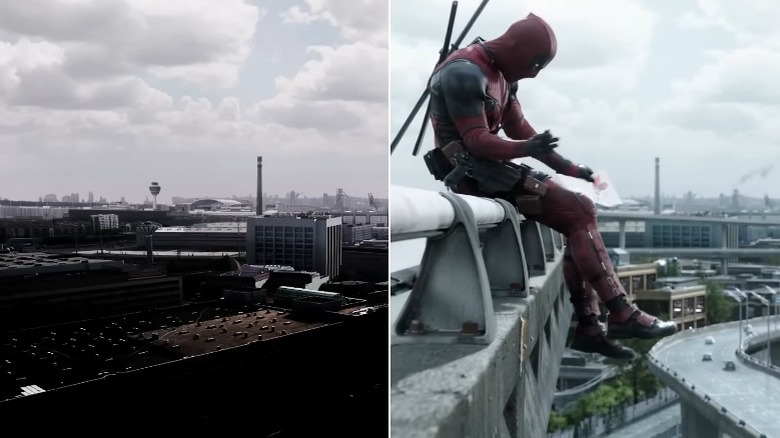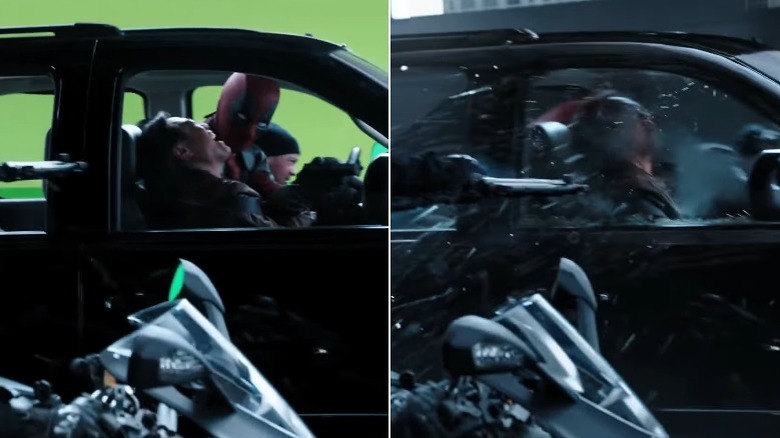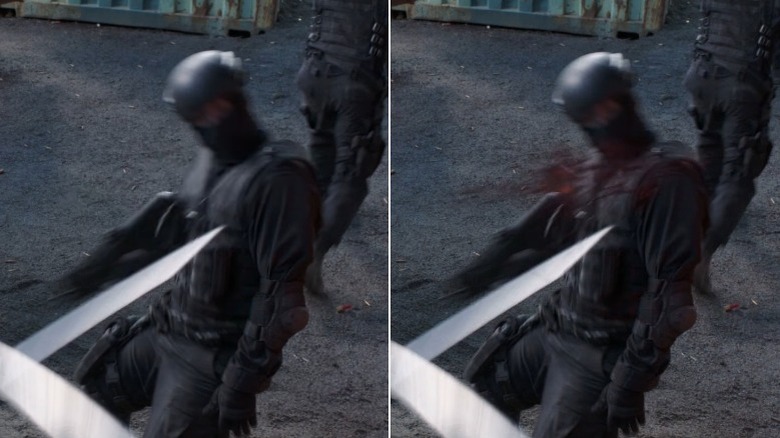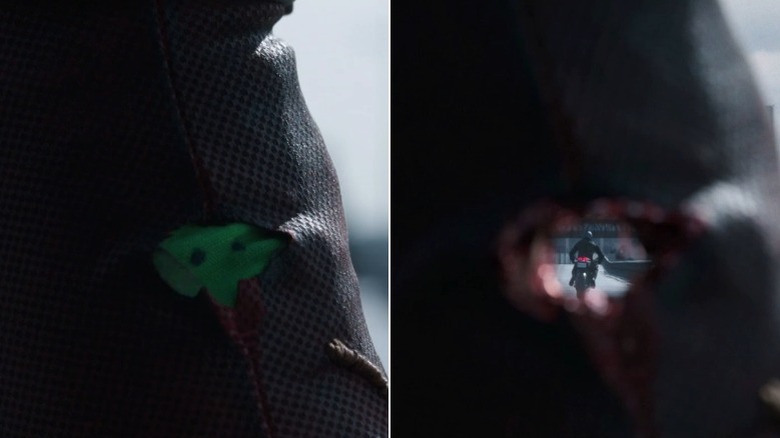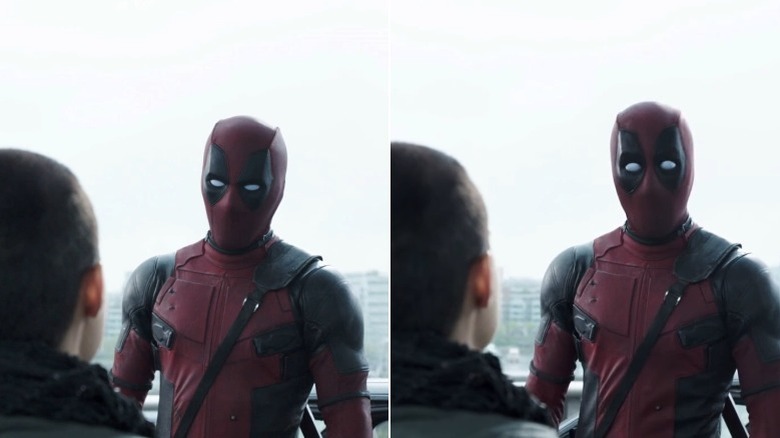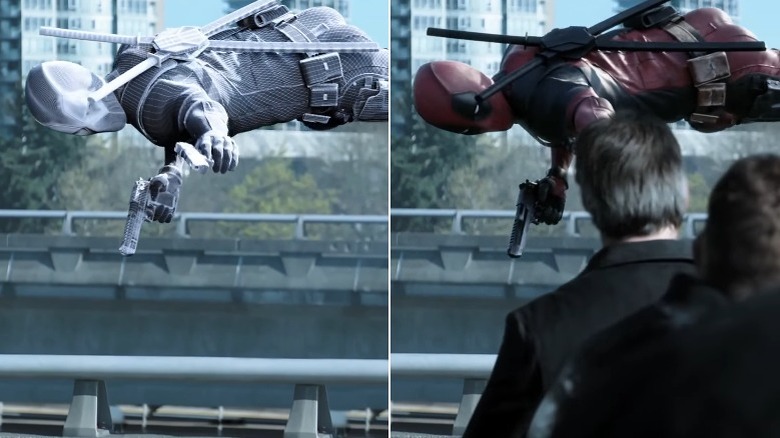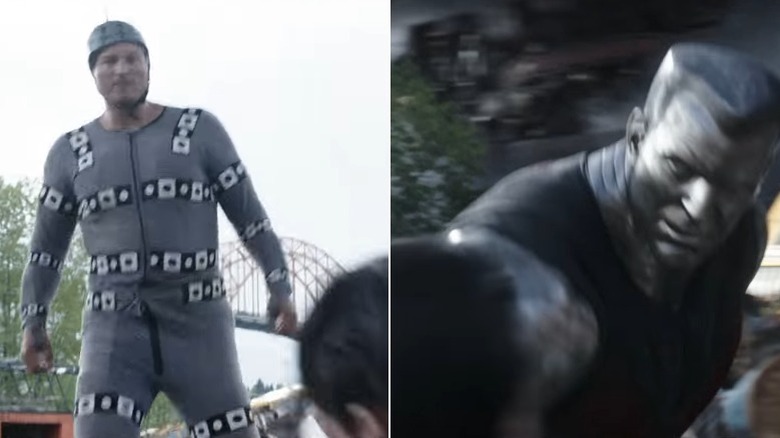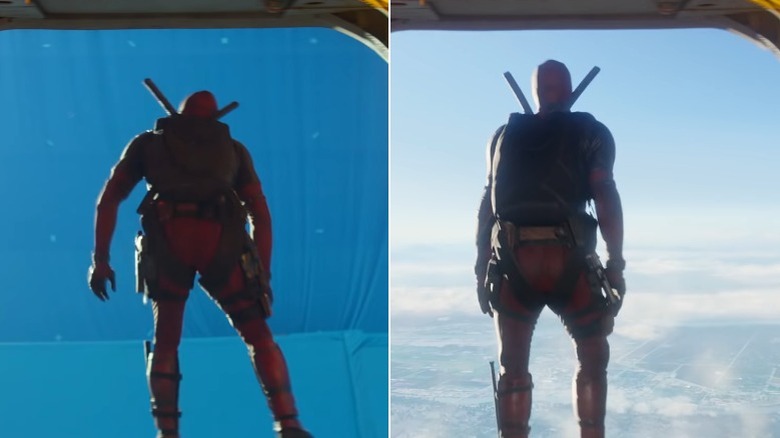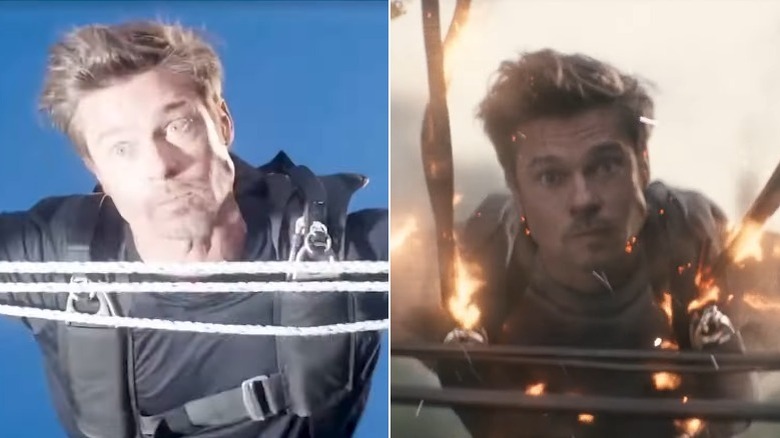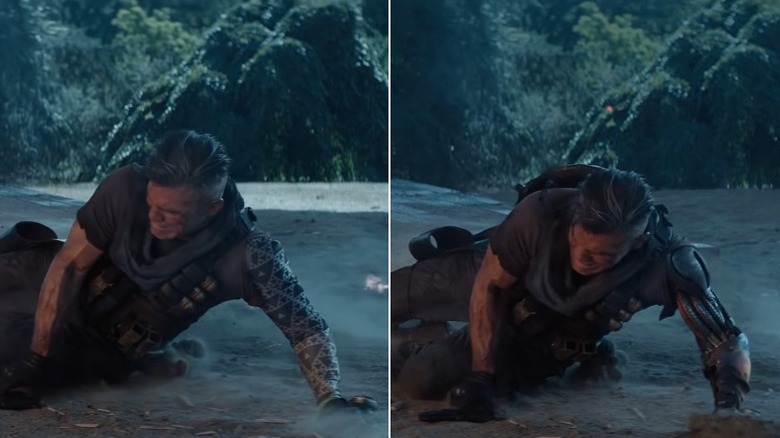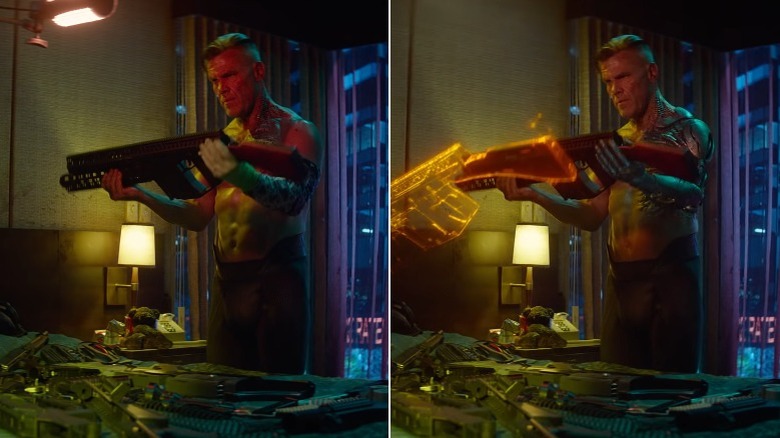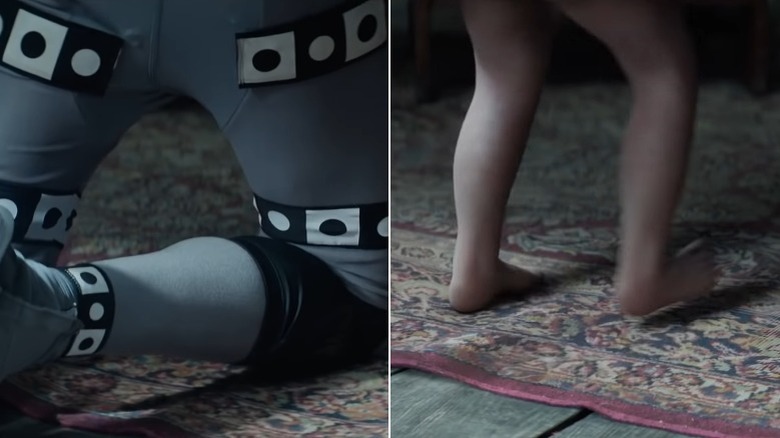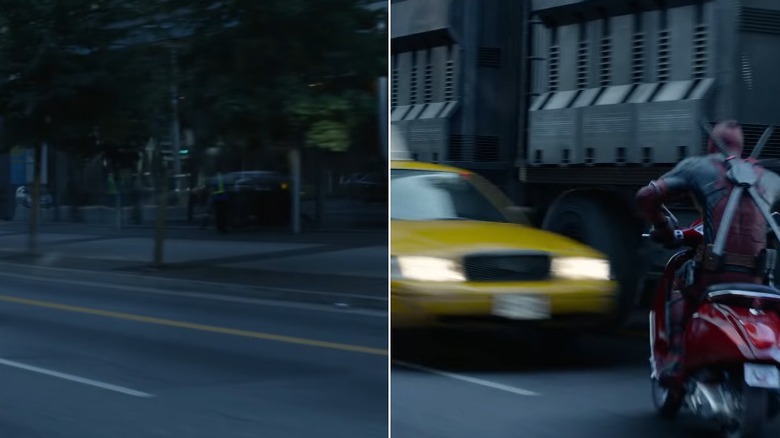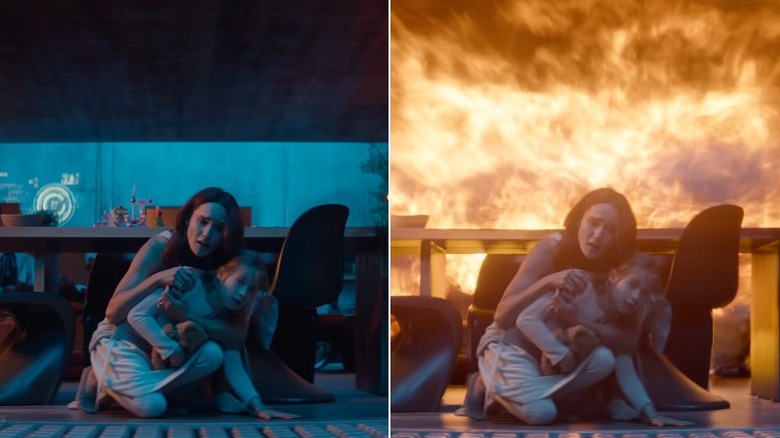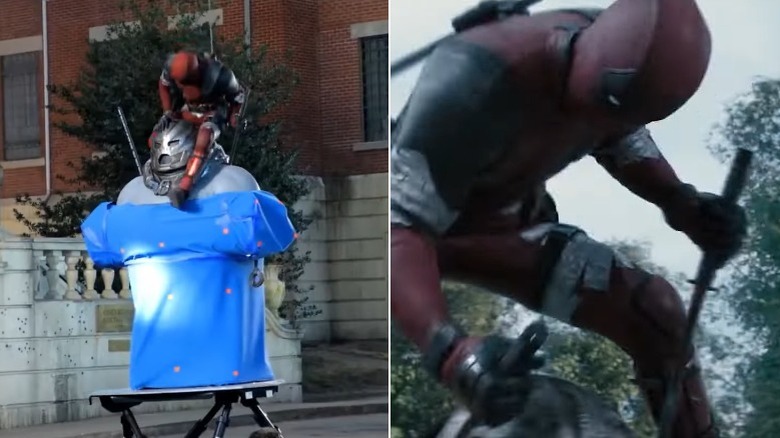What Deadpool Looks Like Without CGI
When the first "Deadpool" film rolled around in 2016, its project of proving the financial viability of offbeat, R-rated superhero films focusing more on humor, character and stunts than bloated CGI setpieces was a daunting one — but its ultimate success was unqualified. By grossing over $780 million worldwide on a budget of merely $58 million, it became a runaway success story that few other films in the genre can compare to.
It was a breath of fresh air for comic book and superhero fans in a lot of ways, beginning with the film's proud recognition of its own underdog status — endlessly poking fun at the limitations of its budget, its VFX, its licensing rights, et cetera. Then came the second film, with a nearly doubled budget but the same basic ethos: Keep it grounded, keep it fun. By holding fast to the same irreverent spirit, it managed to outgross the first.
Yet the "Deadpool" films, despite their relative emphasis on stunts and fights over CGI pyrotechnics compared to some of their Marvel counterparts, both feature an immense amount of CGI, even in shots that look "normal." The key to the functionality of the CGI is that all of it is employed carefully and occasionally hidden, so that its omnipresence doesn't clash with the movies' scrappy, street-level mood. To give you an idea of just how well the CGI work blends into "Deadpool," here are a few examples of what the movie looks like without it.
Creating the city
The "Deadpool" films take place in an unspecified city, but they were shot in Vancouver, Canada, taking advantage of the city's dense landscape to create a setting that felt in line with the story's hyperactive urban sprawl. In several shots, however, Vancouver was merely the backdrop for environments that were almost entirely constructed via CGI and digital compositing. Such is the case of the early shot in the first film, in which Deadpool (Ryan Reynolds) is seen sitting on a guardrail overlooking a large freeway system.
As revealed in an Atomic Fiction VFX reel, the "raw" shot features only an industrial skyline in Vancouver. The freeways and buildings in front of it were then added with CGI, in addition to the trees and cars seen from a distance. The freeway where Deadpool himself is sitting was created with compositing, with the cars, the road, and Reynolds sitting on a guardrail all being shot separately and then combined.
Green screen car chase
Not only were static environment shots in the first scene of the first "Deadpool" largely digitally assembled, but a lot of the visuals in the ensuing car chase were also accomplished with CGI. Several moments of the chase feature cars, motorcycles, freeway tracks, characters, and even entire shots made out of CGI, and among the shots that feature actors, a lot of keying and green-screening were employed.
Such is the case of one particular lateral shot of the car, where Deadpool breaks in to ambush Ajax's men (per the Atomic Fiction reel). First, a real car was filmed, along with all the actors in the shot. Then, a CGI model of the car was created and synchronized with the car's movement. The CGI model was used as a base to create the gunshot and shattering window glass effects, and finally, a background of the freeway wall being passed by at high speed was composited in.
A matter of splatters
The world of "Deadpool," both in comics and in movie form, is talked up a lot for its meta, self-referential, fourth-wall-breaking gags, which enable it to be an endlessly malleable playground of both comedic and narrative mayhem. But another stylistic trademark of "Deadpool" and its particular sense of humor is the gleefully over-the-top violence. The buckets of blood that fly around in both films get to be stunning in their sheer absurdity — almost as though a giallo film were asking you to laugh along with the carnage.
Of course, this is the 21st century, so the production of "Deadpool" didn't exactly use red tempera paint or corn syrup to convey the spilling of fluids during action scenes. Most of the film's blood was made with CGI, including the blood splatters in the scene that finds Deadpool fighting armed goons with dual swords, as revealed in an Image Engine VFX reel. In one shot, the stunt was shot normally, and then the splatters gushing out of a guy's neck were digitally added in.
Through the bullet hole
Speaking of gleeful and comedic violence, one of the reasons why "Deadpool" movies are able to include so much creative flesh-ripping is that Deadpool himself has regeneration powers, such that he can withstand and overcome injuries that often scan as shocking and unexpected for a superhero protagonist. On that note, one of the most memorable moments in the first film is the one in which Deadpool realizes that a bullet has passed clean through his arm, and then watches through his own bullet hole as a motorcycle rides away.
To accomplish the shot, as seen in the Image Engine reel, the VFX technique used was just what you might expect: A hole in the sleeve of Deadpool's suit was filled in with a patch of green keying fabric. Interestingly, there is a lensing difference between the raw shot of the arm — in which the arm is in focus — and the shot in the film in itself, in which the background with the motorcycle is in focus. To pull that off, the arm was blurred in post, while the background was digitally re-assembled with the blurry background of the raw shot as a general reference.
Masks on top of masks
One of the big questions that "Deadpool" fans have when it comes to the film's visual trickery is how Deadpool's mask was created. After all, the character emotes through his mask, with his eyes and the outline of his face moving in accordance with his expressions, in a way somewhat evocative of cartoon logic — but it always looks so seamless that it doesn't even seem like a special effect.
Naturally, it was a special effect, and it's also a complex one. Although Reynolds was actually wearing the full Deadpool getup, including a practical mask, during the shoot, he obviously couldn't move the mask's eyes with his own face, so a CGI model of Deadpool's head was then overlaid on the majority of scenes. This is very visible in a shot that sees Deadpool talk to Negasonic Teenage Warhead (Brianna Hildebrand) at mid-distance. The Image Engine VFX reel shows that the shot was filmed normally, and then Reynolds' bust was filmed separately as he performed Deadpool's expressions in the scene. A CGI head was created out of that performance and overlaid on the physical mask in the shot.
A man made of CGI
It wasn't just Deadpool's mask that often tricked viewers by employing CGI so seamless that it doesn't even look digital. Several shots, particularly including intense acrobatic sequences and other moments that call for more character flexibility, had Deadpool's entire body constructed digitally from scratch.
The very impressive scene in which Deadpool somersaults over a car and shoots at a row of three goons before they can even react is one instance of Deadpool being a de-facto animated character in some parts of the film. In fact, as an Atomic Fiction video details, the scene featured a combo of different effects: The far-off background was composited into the first shot, a CGI model of Deadpool was animated doing the jump, and finally blood splatters and bullet holes were added into the reverse shot. The actors playing the goons, meanwhile, were real — physically present in the first shot, then composited into the reverse shot, most likely via keying. In a way, when you think about it, Deadpool's, uh, interaction with them — to be as euphemistic as possible — decisively marks him as our very own 21st-century Roger Rabbit.
Tracking for Colossus
If Deadpool is a character whose all-CGI presence in specific shots may come as a surprise to viewers who would otherwise assume it was just Reynolds in a suit, Colossus (voiced by Stefan Kapičić), one of Deadpool's several X-Men partners who weren't exactly picked for their powers, is probably easier to spot as a digital creation, what with his action figure build and shiny steel skin. Several fake pictures of Reynolds being carried by and interacting with various large men, supposedly stand-ins for Colossus later replaced by the final character, have made the rounds on the internet since the film's release. In reality, most shots of Colossus didn't call for any stand-in. Although the character's appearance and expressions were accomplished with the help of several different performers in motion capture sessions, he was mostly assembled in isolation and then added into the "blank" in the final shots.
Be that as it may, there was a stand-in who appeared in Colossus' place in several shots, most notably when any sort of clear physical interaction between the character and live actors took place. The stand-in was Canadian actor and stuntman Andre Tricoteux, who donned a motion tracking suit in his scenes. As shown in a WIRED behind-the-scenes featurette, a particular shot of a fist fight between Colossus and Angel Dust (Gina Carano) was done by filming Tricoteux and Carano sparring for real, and then replacing Tricoteux with Colossus digitally.
A much safer helicopter dive
"Deadpool 2" notoriously features the X-Force, in a sequence that befits the franchise's irreverence and penchant for exaggerated violence when it comes to its interpretation of the comics' mythos. The infamous scene in which the team attempts to raid a prison convoy by descending upon it via skydiving, only for everyone but Deadpool and Domino (Zazie Beetz, who isn't returning in "Deadpool & Wolverine") to die during the landing, begins, of course, in the air. In real life, however, the shooting of the scene involved much less of a safety hazard.
The helicopter from which Deadpool jumps was a practical set, but Reynolds was filmed in front of a blue chroma screen, as shown in a DNEG VFX reel. The screen was then replaced with the outside of the helicopter, while Reynolds himself was replaced with a CGI model of Deadpool, thus enabling the continuous shot following the character from the interior of the helicopter out into the open sky.
Frying Brad Pitt
The sequence depicting the X-Force's demise in "Deadpool 2" features a series of comically absurd catastrophes, with Terry Crews as Bedlam, Bill Skarsgård as Zeitgeist, Lewis Tan as Shatterstar, Rob Delaney as Peter, and Brad Pitt as Vanisher, all dying ingloriously. Vanisher's death is particularly memorable, due to its wow factor: Although the character has the gift of invisibility, he ends up getting electrocuted by power lines while skydiving, and thus becomes visible right before dying. Brad Pitt's cameo in those few seconds took a lot of viewers by surprise, and even the studio was thoroughly confused by it.
Pitt, whose cameo was a way for him to still be in the film after turning down the role of Cable due to scheduling issues, was placed on ropes suspended in front of a blue chroma screen for the scene, as can be seen in a TheThings behind-the-scenes video. Practical light flashes were then used to facilitate the visual of Vanisher getting lit up by the electricity.
Armed and dangerous
Cybernetic soldier Cable (Josh Brolin) is among the Marvel characters with the most distinctive design, and "Deadpool 2" naturally didn't skimp on bringing it to life. The most iconic visual feature of Cable — as well as his most dependable weapon — is his metal arm, which, unlike much of his body, is in fact a metal prosthesis instead of a natural formation caused by the techno-organic virus. And it was incorporated into the film with particular centrality.
The method used by the VFX team to give Cable his bionic limb was simple: Put Brolin's left arm in a motion tracking sleeve, and then create the arm with CGI. This allowed Brolin to act with his arm and thus do proper justice to Cable's relationship with his prosthetic body part-slash-armament. A shot from the DNEG VFX reel in which Cable kneels on the ground after a fall and uses his arm to retain balance is especially illustrative.
Enhancing Cable
Josh Brolin is no stranger to playing Marvel Comics villains with digitally enhanced appearances and surprisingly sympathetic motivation. After all, he was never fond of the idea of playing superheroes, but was more than happy to play their nemeses. Although Cable is significantly less gigantic, less purple, and less of a narcissistic jerk than Thanos, the VFX team of "Deadpool 2" still took a page from the MCU when it came to creating and animating a CGI model in Brolin's likeness, as several shots bring Cable's cybernetic body to life by superimposing an all-digital Brolin on the real one.
In DNEG's effects reel, one shot of Cable in his motel room, standing in front of the bed and holding a large gun, didn't go to such extremes, but still used a lot of CGI to fill out the character's unique appearance. Brolin was actually filmed holding a practical gun prop in the set, with some makeup applied on him. The entire left side of his upper body was then transformed into Cable's via CGI, which was also used to create the 3D diagram of the gun projected by Cable's eye scan.
On your knees
The ability of Wade Wilson to recover from even the most extreme injuries and disfigurements to his body is a recurring plot point in both "Deadpool" films. "Deadpool 2" takes that power to the extreme by depicting Wade's healing process after blowing himself to bits in a desperate suicide attempt, and then again later in the film, in a much less emotionally fraught context, when he is ripped in half by Juggernaut.
Wade's body then begins its slow process of regeneration, leading to the surreal image of Wade maintaining an adult body from the waist up while his legs are still growing into their normal size. To film the scene with "baby legs," Reynolds wore motion tracking pants, and moved his legs more or less as Wade would be moving them, as seen in a DNEG reel (via Fame Focus). For the shots in which he walks towards Cable and stands in front of him, Reynolds was required to walk on his knees.
Just a normal Vancouver street
Wade Wilson's city may not be given an official name in the films, but Deadpool is an intrinsically Canadian entity. Unlike other Hollywood films, no attempt is made to dress up the Vancouver filming locations — Ryan Reynolds' own birthplace, incidentally — as belonging to any other town. Like many other characters in "Deadpool," the city of Vancouver also alternates between physical presence and CGI emulation.
Indeed, just as some external scenes in both "Deadpool" films place the actors and props in entirely or near-entirely digital environments, there are moments that invert the equation by adding all-digital elements to real physical locations. The DNEG reel shows that, in one particular shot of the mid-film car chase, with Domino driving the prison truck while Deadpool trails behind it on his motorcycle, literally everything except the street itself is CGI. This goes for the truck, the motorcycle, Deadpool himself, and of course, the cab that hits him. Vancouver, however, is 100% practical.
Burning down the house
For the vast majority of the fire effects shown when Russell Collins, a.k.a. Firefist (Julian Dennison), is using his powers, CGI was used, as tends to be the case when it comes to cinematic flames. This applies to simpler shots of his hands becoming incandescent, as well as denser ones, such as the tragic flash-forward that depicts the death of Cable's wife (Hayley Sales) and daughter (Islie Hirvonen) by Russell's hand.
The shot of the flames finally reaching and consuming the office where the two characters are hiding was accomplished by adding CGI fire to an otherwise standard practical shot. As seen in a DNEG featurette, Sales and Hirvonen did the hiding in the physical office set, kneeling behind the desk, and then the burst of fire was added in layers: First the lighting and shading it would produce, then a distortive fuzz around the area through which the fire would be passing, then the flames themselves, then a lens flare.
Juggernaut was practical... sort of
A running theme that emerges from a behind-the-scenes look at the "Deadpool" visual effects is the combination of the practical and the digital. From Deadpool and his mask to Colossus and his stand-in to Cable and his bionic body to the various props, sets, and objects shaped by creating CGI models of practical designs, much of the digital wizardry in the two films endeavors to be as organic as possible. This is especially true of interactions between CGI animation and the physical world, such as Deadpool's mid-fight acrobatics — but, in the case of Juggernaut, it's Ryan Reynolds who's made to interact with a CGI character.
There was no human stand-in for the character in question — nor even a separate voice actor, as Reynolds provided the voice and facial motion capture for Juggernaut (who is listed as playing "himself" in the credits), in an instance of how his work on the "Deadpool" movies went on long after filming wrapped. Instead, a large, static Juggernaut dummy with a tracking chroma suit was used for reference in the character's animation, which came in especially handy in the scene where Deadpool is struggling against Juggernaut while standing on the giant's shoulders, as seen in the TheThings video.
Now we can't wait to see what kind of CGI mayhem awaits us in "Deadpool & Wolverine," bringing the Merc with a Mouth to the MCU.
